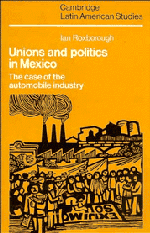Book contents
- Frontmatter
- Contents
- List of tables
- List of figures
- Acknowledgements
- Dedication
- Preface
- List of abbreviations
- Map: Location of automobile plants
- 1 Organized labour in Mexico
- 2 The Mexican automobile industry
- 3 Wages and workers in the Mexican automobile industry
- 4 The unions: a historical analysis
- 5 The unions: power and organization
- 6 Control over work processes
- 7 Union government
- 8 The labour courts
- 9 The empirical findings and the dynamics of industrial militancy
- 10 Unions and political stability in Mexico
- Notes
- Bibliography
- Index
- CAMBRIDGE LATIN AMERICAN STUDIES
- Frontmatter
- Contents
- List of tables
- List of figures
- Acknowledgements
- Dedication
- Preface
- List of abbreviations
- Map: Location of automobile plants
- 1 Organized labour in Mexico
- 2 The Mexican automobile industry
- 3 Wages and workers in the Mexican automobile industry
- 4 The unions: a historical analysis
- 5 The unions: power and organization
- 6 Control over work processes
- 7 Union government
- 8 The labour courts
- 9 The empirical findings and the dynamics of industrial militancy
- 10 Unions and political stability in Mexico
- Notes
- Bibliography
- Index
- CAMBRIDGE LATIN AMERICAN STUDIES
Summary
As indicated in chapter 1, the prevailing notion concerning union government in Mexico is expressed in the concept of charrismo. This has come to be used as a catch-all epithet to describe a variety of union practices. The term is largely devoid of analytic utility, as may be seen from the following representative statement:
Charrismo is a particular form of trade union control which is characterized by: (a) the use of the repressive forces of the state to support a trade union leadership; (b) the systematic use of violence; (c) the permanent violation of workers' union rights; (d) misuse and theft of trade union funds; (e) dishonest dealing with the workers' interests; (f) connivance between union leaders and the government and capitalists; (g) corruption in all its forms.
In this usage, charrismo simply indicates that the author or speaker disapproves of the union leadership in some way. Furthermore, there is a generalized belief that Mexican unions typically are charro unions. Yet there appear to be very few serious studies of internal union government in Mexican unions. This belief is a generalization from a number of specific cases, such as the 1958–9 railway strike.
Two questions immediately spring to mind: (a) to what extent is this picture of charrismo an accurate description of Mexican unionism? (b) If non-charro unions exist, are they more likely to be found among the ‘independent’ unions, or are these also breeding grounds for charrismo?
- Type
- Chapter
- Information
- Unions and Politics in MexicoThe Case of the Automobile Industry, pp. 132 - 144Publisher: Cambridge University PressPrint publication year: 1984
- 1
- Cited by

